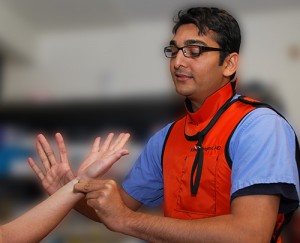Transradial Catheterization and Interventions
 Catheterization is a key diagnostic tool for cardiac health. Traditionally, a line is threaded through the femoral artery in the groin and up into the heart, requiring patients to lie flat for several hours, and remain flat and immobile for some time after the procedure. Although considered safe, there is some risk of bleeding with a traditional catheterization. The radial artery approach removes the need for hours of horizontal immobility, as well as greatly reducing the risk of bleeding.
Catheterization is a key diagnostic tool for cardiac health. Traditionally, a line is threaded through the femoral artery in the groin and up into the heart, requiring patients to lie flat for several hours, and remain flat and immobile for some time after the procedure. Although considered safe, there is some risk of bleeding with a traditional catheterization. The radial artery approach removes the need for hours of horizontal immobility, as well as greatly reducing the risk of bleeding.
Transradial catheterization offers patients these benefits:
- Improved comfort
- Reduced risk for bleeding
- Fewer complications
- Shorter recovery time
- Quicker discharge
Am I a good candidate for treatment?
This procedure is of extreme benefit to those patients who cannot lay flat for long hours, like those with back pain issues, emphysema, and congestive heart failure, among other conditions.
What can I expect after treatment?
After the procedure is finished, the catheter and IV will be removed. Firm pressure will be applied to the radial artery to stop any bleeding and bandages will be applied.
The patient may feel a little sleepy until the sedative has worn off. Nurses will watch to see that the patient’s heart rate and blood pressure are normal. After a short time of rest, the patient will be able to go home.
Deborah Specialty Physicians is performing almost all types of procedures through the radial artery, including catheterizations for complex bifurcation stenting, vein graft stenting, and emergency care during heart attack. We also perform peripheral procedures such as kidney artery stenting, subclavian stenting, and in selected cases Iliac artery intervention through this approach.
